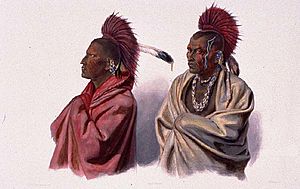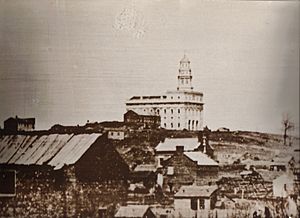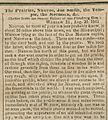History of Nauvoo, Illinois facts for kids
The history of Nauvoo, Illinois, began with the Sauk and Fox Native American tribes. They called the area "Quashquema" after a chief who led a large village of nearly 500 homes.
The first non-Native settlers arrived around 1824. By 1829, the area, then called "Venus," had grown enough for a post office. In 1834, its name changed to "Commerce" to better fit the settlers' plans. In late 1839, members of the Latter Day Saint movement bought Commerce. In April 1840, Joseph Smith, their prophet, renamed it "Nauvoo," a Hebrew word meaning "they are beautiful."
Nauvoo grew very quickly and became one of the largest cities in Illinois for a few years. However, after Joseph Smith's death in 1844, most of the people left within two years because of violence. Many headed west with the group led by Brigham Young.
In 1849, a group called the Icarians moved to Nauvoo to start a utopian community where everyone shared resources. In the 1900s, Nauvoo became mainly a Catholic town, and most of its people today are Catholic. Nauvoo is now a popular place for tourists, especially Latter Day Saints, who visit its restored historic buildings.
Contents
Early Native American Life
A large village of Sauk and Meskwaki people lived near what is now Nauvoo, along the Mississippi River. This village was established in the late 1700s and had as many as 1,000 homes.
Around 1823 or 1824, Captain James White bought the village land from Quashquame, a Sauk leader. Quashquame's village then moved to the west side of the river, joining another Sauk village near Montrose, Iowa.
In 1841, Joseph Smith, Jr., who lived in Nauvoo, was visited by Sauk and Meskwaki people from the Iowa village. Joseph Smith met with chiefs like Keokuk and about one hundred other leaders and their families. He talked to them about the Latter Day Saint religion, and they had a feast with dancing.
Latter Day Saints Settle Nauvoo
In early 1839, Latter Day Saints were forced to leave Missouri because of conflict. They found safety in Quincy, where local citizens welcomed them.
Joseph Smith, Jr., the prophet and leader of the Church of Jesus Christ of Latter Day Saints, was held in prison in Missouri. However, his advisor, Sidney Rigdon, was released and joined the church members in Quincy.
A church member named Israel Barlow learned about a large amount of land for sale in the Commerce area. He contacted church leaders. The church leaders bought this land in 1839, and Latter Day Saints immediately began to settle there.
Joseph Smith and other leaders were allowed to escape from prison and joined the Latter Day Saints in Commerce by May 1839. Smith then renamed the town "Nauvoo," meaning "to be beautiful." Many Latter Day Saints called Nauvoo "the city beautiful" or "the city of Joseph."
At first, the area was a swamp. Many people got sick from diseases like cholera and malaria until the swamp was drained. Since Commerce had few buildings, new homes were quickly built. Joseph Smith had a city plan called the "plat of Zion," which was used for Nauvoo's streets and lots. The city had wooden homes with gardens and orchards, laid out in an organized grid.
Building the City
In 1840, John C. Bennett, a military officer, joined the Latter Day Saints and became Joseph Smith's friend. Bennett helped Smith create a special city charter for Nauvoo. This charter gave the city important powers, like setting up its own court, a university, and a local army. Both the Democratic and Whig political parties in Illinois wanted the Mormon votes, so they quickly approved the charter.
After the charter passed, Bennett became Nauvoo's first mayor. Smith also made Bennett a church leader. A local army, called the "Nauvoo Legion," was formed, and Smith and Bennett became its commanding generals.
The city grew rapidly as more Latter Day Saints moved in. At its busiest, Nauvoo's population was similar to Quincy's or Springfield's. Many new residents came from the British Isles because of successful church missions there. The Latter Day Saints published two newspapers in the city: the religious Times and Seasons and the independent Wasp. The University of Nauvoo was also established, though it mostly existed on paper.
The Nauvoo Legion, the city's army, had 2,000 men and was led by Joseph Smith.
On April 6, 1841, the Nauvoo Legion had a big parade to celebrate the start of a new temple. The Nauvoo Temple was a large stone building. Its foundation was 83 feet by 128 feet, and when finished, its steeple reached over 100 feet high. Another large building, the Nauvoo House hotel, was also started.
In October 1841, a Masonic group was started in Nauvoo. Many church leaders joined this group.
Church Leadership Changes
When Nauvoo was founded, the church was led by Joseph Smith and two counselors. After John C. Bennett was removed from his positions in 1842, Joseph Smith became the city's second mayor. In 1844, Smith even ran for President of the United States.
Growing Problems for Latter Day Saints
As the Latter Day Saint population grew, non-Mormons in nearby towns like Warsaw and Carthage felt worried. They saw the Latter Day Saints as having too much political power because they often voted together. Joseph Smith was not only the church president but also the mayor, head of the city court, and general of the army. This power, along with the Latter Day Saints' ability to work together, made some non-Latter Day Saints suspicious.
Throughout this time, officials from Missouri tried to arrest Joseph Smith. When he was caught, Smith would ask the Nauvoo city court to release him, which they often did.
In 1844, a former church leader named William Law started a newspaper called the Nauvoo Expositor. Only one issue was printed.
On June 10, Joseph Smith and the city council decided the Expositor was a "public nuisance." Smith ordered the press to be destroyed. A part of the Nauvoo Legion went to the office, broke the press, and burned all copies of the newspaper they could find.
Many people outside Nauvoo saw this action as illegal. Critics, like Thomas Sharp, whose newspaper in Warsaw had been calling for the church's destruction, used this event to stir up anger. Some non-Mormons and former church members called for Smith's arrest. Smith, his brother Hyrum, and other church leaders agreed to be arrested. While they were waiting for trial in Carthage, a mob attacked the jail, and Joseph and Hyrum Smith were killed.
The Exodus from Nauvoo
Quick facts for kids Illinois Mormon War |
|||||||
|---|---|---|---|---|---|---|---|
| Part of the Mormon wars | |||||||
 Depiction of the Battle of Nauvoo, by C.C.A. Christensen |
|||||||
|
|||||||
| Belligerents | |||||||
| Nauvoo Legion | |||||||
| Commanders and leaders | |||||||
Thomas Brockman |
Joseph Smith† Brigham Young Hosea Stout Daniel H. Wells |
||||||
| Strength | |||||||
| About 1,000 | Less than 150 | ||||||
| Casualties and losses | |||||||
| Unknown number wounded | About ten killed, unknown number wounded | ||||||
After Joseph Smith's death, the problems against the Latter Day Saints continued. This conflict is sometimes called the "Mormon War in Illinois." People who opposed the Latter Day Saints wanted them to leave Illinois.
In October 1844, a large gathering was planned in Warsaw. It was called a "wolf hunt," but everyone knew the "wolves" were the Latter Day Saints. Governor Thomas Ford sent soldiers to stop the gathering. However, many soldiers started to agree with the anti-Mormon views.
Groups of people continued to roam the county, forcing Latter Day Saints in outlying areas to leave their homes and gather in Nauvoo for safety.
In December 1844, the Illinois state government discussed taking away Nauvoo's special city charter. Governor Ford admitted the charter's powers had been "abused," but he wanted to just change it. However, on January 29, 1845, the charter was removed by a large vote.
After losing its city charter, Nauvoo's government was dissolved. The church's leaders then managed the city's affairs. Nauvoo's population reached its highest point around 1845, possibly with as many as 12,000 people. This made it almost as big as Chicago, which had about 15,000 people at the time.
On September 10, 1846, a mob of about 1,000 anti-Mormons attacked Nauvoo. Three of the fewer than 150 Latter Day Saint defenders were killed. About a week later, on September 16, the Latter Day Saint leaders surrendered. They arranged for their people to leave the town and cross the Mississippi River into Iowa.
After the Latter Day Saints left, the temple stood until it was destroyed by arsonists on November 19, 1848. On April 3, 1999, plans were announced to rebuild the temple. Construction began on October 24, 1999, and the new temple was dedicated on June 27, 2002.
Many years later, on April 1, 2004, the Illinois House of Representatives passed a resolution. This resolution expressed regret for the forced removal of the Latter Day Saints from Nauvoo in 1846.
Later History
Emma Hale Smith, Joseph Smith's widow, continued to live in Nauvoo with her family. In 1860, their son, Joseph Smith III, became the leader of a group now known as the Community of Christ. He lived in Nauvoo, which was the church's headquarters until 1865. Later, the church headquarters moved to Plano, Illinois, and then to Independence, Missouri.
Icarian Community
In 1849, a group called the Icarians moved to Nauvoo. They wanted to create a utopian community based on the ideas of French philosopher Étienne Cabet. This meant they tried to live together with shared ideals and resources.
At its peak, the community had over 500 members. However, disagreements and the death of Cabet in 1856 caused some members to leave. They moved to other Icarian communities in Illinois, Iowa, and California. Descendants of this Icarian colony still live in the area today.
Catholic History
In the early and mid-1900s, Nauvoo was mainly a Catholic town. Most of the people living there today are Catholic.
On October 15, 1874, Sister Ottilia Hoeveler and four other sisters came from Chicago to start a girls' school. It was first called St. Scholastica Academy and opened on November 2, 1874, with seven girls.
In 1879, the convent became independent, and the school's name changed to St. Mary's Academy. The convent became St. Mary's Convent. New buildings were added in 1892 and 1897.
In 1907, a boys' school, Spalding Institute, was built. It closed in 1920 but reopened in 1925 as St. Edmund's Hall. This school closed in 1940, and the building became a new convent called Benet Hall.
More buildings were added in the 1950s and 1960s, including a Monastery (1954), a High School (1957), and a Dormitory (1967). Enrollment changed after the 1960s, and St. Mary's Academy closed in June 1997 due to fewer students.
St. Mary's was later sold and used as the Joseph Smith Academy until 2006. The building began to be torn down in September 2007.
Today, Sts. Peter and Paul Elementary still provides education for students from pre-kindergarten through sixth grade.
Images for kids







